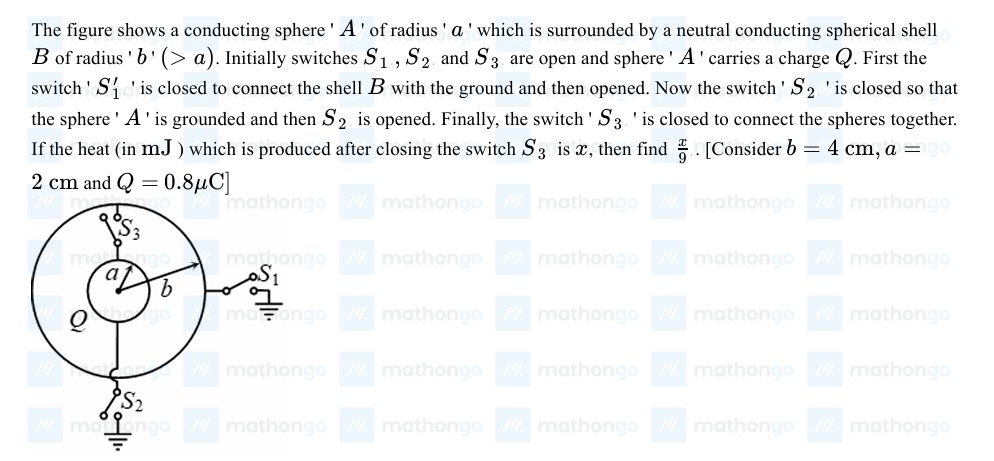Question
Question: The figure shows a conducting sphere 'A' of radius 'a' which is surrounded by a neutral conducting s...
The figure shows a conducting sphere 'A' of radius 'a' which is surrounded by a neutral conducting spherical shell B of radius 'b' (> a). Initially switches S1,S2 and S3 are open and sphere 'A' carries a charge Q. First the switch 'S1' is closed to connect the shell B with the ground and then opened. Now the switch 'S2' is closed so that the sphere 'A' is grounded and then S2 is opened. Finally, the switch 'S3' is closed to connect the spheres together. If the heat (in mJ) which is produced after closing the switch S3 is x, then find 9x. [Consider b=4 cm, a=2 cm and Q=0.8μC]

2
Solution
The problem involves a sequence of electrostatic processes. Let's analyze the charge distribution and potential energy at each stage.
Initial state: Sphere A has charge Q, shell B is neutral. Switches S1,S2,S3 are open.
Step 1: S1 is closed to ground shell B, then opened. When B is grounded, its potential becomes zero. Sphere A has charge Q. Charge −Q is induced on the inner surface of B. When grounded, the outer surface charge goes to the earth. So, after grounding B, the shell B has a total charge of −Q, distributed on its inner surface. Sphere A still has charge Q.
Step 2: S2 is closed to ground sphere A, then opened. Now sphere A is grounded, so its potential is zero. Shell B has charge −Q on its inner surface. Let the new charge on A be Q′. The potential of A is VA=4πϵ01aQ′+4πϵ01b−Q. Since VA=0, we have aQ′=bQ, so Q′=Qba. After this step, sphere A has charge QA=Qba, and shell B has charge QB=−Q on its inner surface. The outer surface of B has zero charge.
Step 3: S3 is closed to connect A and B. When A and B are connected, they form a single conductor. Charge will redistribute until they are at the same potential. Since A is inside B and they are connected, the combined charge will reside on the outer surface of the system. The total charge on the combined system is Qtotal=QA+QB=Qba+(−Q)=Q(ba−1). This charge will reside on the outer surface of shell B. The final configuration is a spherical shell of radius 'b' with charge Qfinal=Q(ba−1) on its outer surface.
The heat produced when S3 is closed is the loss in potential energy: x=Ubefore S3−Uafter S3.
Before closing S3, sphere A has charge Q′=Qba and shell B has charge −Q on its inner surface. The potential energy before S3 is the energy stored in the electric field between A and B. For a<r<b, the electric field is E(r)=4πϵ0r2Q′. The potential energy in this region is Uab=∫ab21ϵ0E2dV=∫ab21ϵ0(4πϵ0r2Q′)24πr2dr=8πϵ0(Q′)2∫abr21dr=8πϵ0(Q′)2(a1−b1). Substituting Q′=Qba, Ubefore S3=8πϵ0(Qa/b)2abb−a=8πϵ0Q2a2/b2abb−a=8πϵ0b3Q2a(b−a).
The potential energy after closing S3 is Uafter S3=214πϵ0b(Q(ba−1))2=8πϵ0bQ2(a/b−1)2=8πϵ0bQ2(a−b)2/b2=8πϵ0b3Q2(b−a)2.
The heat produced is x=Ubefore S3−Uafter S3=8πϵ0b3Q2a(b−a)−8πϵ0b3Q2(b−a)2=8πϵ0b3Q2(b−a)[a−(b−a)]=8πϵ0b3Q2(b−a)(2a−b).
Given values: a=2 cm = 0.02 m, b=4 cm = 0.04 m, Q=0.8μC=0.8×10−6C. b−a=0.04−0.02=0.02 m. 2a−b=2(0.02)−0.04=0.04−0.04=0.
So, x=8πϵ0b3Q2a(b−a). x=8×9×1091×(0.04)3(0.8×10−6)2×0.02×0.02=8×0.0000640.64×10−12×0.0004×9×109. x=8×64×10−60.64×4×10−16×9×109=512×10−62.56×9×10−7=51223.04×10−1=5122.304=0.0045. x=0.0045J=4.5mJ.
Where is the error?
Let's check if the formula is correct: x=8πϵ0b3Q2a(b−a). 8πϵ0=9×1092. x=9×1092×(0.04)3(0.8×10−6)2×0.02×0.02=2×0.0000640.64×10−12×0.0004×9×109=2×64×10−60.64×4×10−16×9×109. x=128×10−62.56×9×10−7=12823.04×10−1=1282.304=0.018. x=0.018J=18mJ.
So x=18 mJ. 9x=918=2.
